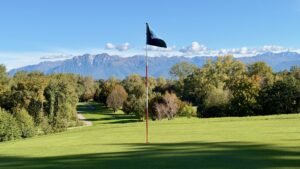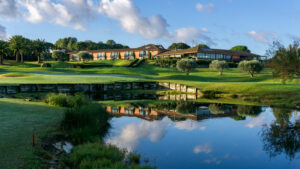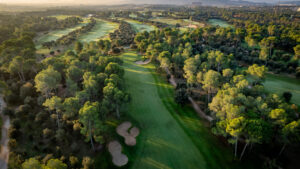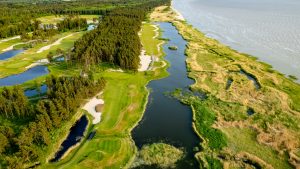Most people associate Kenya with going on safari to see the Big Five. But there is much more to Kenya than wildlife. We traveled to Kenya and went on a different kind of safari: a golf safari.
Being an old British colony, Kenya has a long golf tradition. There are over 40 golf courses throughout the country. Some offer an environment that makes you feel like you have traveled back in time, some offer a combined golf and wildlife experience, and some offer more of a traditional resort experience, but with an African twist. We visited one of the latter.
About an hour north of Mombasa, on a ridge along the Indian Ocean coast you find the newest golf project in Kenya, Vipingo Ridge.
Vipingo Ridge is a very ambitious project, with two 18 hole golf courses (one finished and one planned), 250 high-end villas, a full-service clubhouse, and a number of other activities for guests and residents. Within its walls, Vipingo Ridge even has its own airport, complete with a paved runway capable of receiving regional jet aircraft carrying up to 120 passengers. Vipingo Ridge is currently negotiating with Kenya Airways about getting a direct route in.
The first course, the Baobab course, was designed by Northern Irish architect David Jones and finished in 2009, constructed to meet USGA specifications. The course runs along a ridge, with numerous elevation changes, making for many interesting holes. In spite of being on top of a ridge, the course features several small lakes. This was accomplished by pumping water up to a large dam, and then letting the water flow down the ridgeline in streams and waterfalls, adding to the natural beauty of the course, while at the same time solving an otherwise hard-to-solve irrigation problem. The result is both beautiful and natural-looking and means the course can stay in top shape regardless of the season.
The Baobab course starts with a reasonably easy downhill par four, followed by another par four, both with a magnificent view of the sunrise over the Indian Ocean. After the first two holes, the course climbs and several holes run along the ridge. On the 8th hole, a short par three, you encounter the first of the lakes, guarding the green on the left. The 9th takes you uphill back to the clubhouse, with the green guarded by another lake.
The second nine takes you to the other side of the ridge, again with magnificent views, this time looking inland. Again following the ridgeline, you get challenged by a good mix of holes, leading up to a beautiful finish starting on hole 16, a par four dogleg right. From the elevated tee, you have to be precise, with a lake on the left and forest on the right. If you manage, your second challenge is a long, uphill approach to a green defended by bunkers in front, and a stream running down the left edge of the fairway. On the next hole, you get another chance to lose your ball into the water. The 17th is a mirror image of the 8th, this time with the water on the right. And the 18th, a par five, runs uphill to the clubhouse, parallel with the 9th, finishing with the lake to the right side of the green. The combination 8-9-17-18 provides for a stunning view from the clubhouse, especially from the roof bar and terrace. Well done, David Jones.
After golf, you can enjoy lunch or dinner at the fine clubhouse restaurant, or take part in one of the many other activities offered, among them tennis and horseback riding. Or you can pay a visit to the private beach run by Vipingo. The beach is part of an EU sponsored coral reef restoration project, and you can walk out to the reef and snorkel, with or without a local guide. From being almost totally destroyed, the reef is now alive and thriving, making for exciting snorkeling. You can also charter a boat and go fishing outside the reef. The waters outside are among the top three in the world for deep-sea fishing, and you’ll have a good chance to catch marlin, tuna, and barracuda, among others.
In spite of having 250 villas you don’t see very many of them from the course. The ones that line a few of the holes are well hidden by vegetation, and most of the villas are away from the course on the very large Vipingo property. The villas are all privately owned, including one owned by Ian Woosnam, but some of them are offered for rent to visitors. We stayed in one of the three rows of villas a short walk below the clubhouse, facing the Indian Ocean. All of the villas have multiple bedrooms and kitchenettes, and many feature private roof pools.
Caddies are mandatory at Vipingo Ridge. Many of the caddies come from the Glad’s House charity that supports Kenyan street children through sport and education. The future caddies are brought to Vipingo and trained through a cooperation with the caddies of the European Tour. They also learn to play golf and get to play unlimited golf on Mondays. Several of the caddies we encountered were now single handicappers. It was a pleasure to get to know them, and we gladly paid them double the going rate, which came to around 12 USD. By the way, if your caddie is named Patrick, that is no coincidence. When Irish missionaries came to Kenya, they named everyone Patrick, or so the story goes.
Apart from the Baobab course, there is also a driving range with target greens, two putting greens, and a chipping and bunker practice area. A second 18-hole course is in the planning stages.
In Kenya, Christmas is the height of summer, and temperatures can climb into the mid-30s Celsius. The high season is early in the year, and also between July and October. Kenya has two rain periods, the “short rains” in March/April, and the “long rains” in October/November. We visited in late February, and the weather was ideal for golf.
All in all, Vipingo is a top-class facility, easily the number one course in Kenya in our opinion. We highly recommend it.






